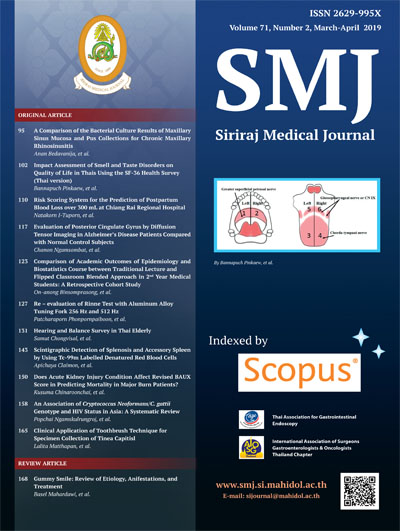Hearing and Balance Survey in Thai Elders
DOI:
https://doi.org/10.33192/Smj.2019.21Keywords:
Balance; hearing loss; falls; elderly; ear pathology; aging; screeningAbstract
Objective: To survey hearing and balance problems of a sampling group of Thai elders in the central region of Thailand.
Methods: A population study was people aged 60 and over who agreed to join the survey at the 14 elderly social associations. The questionnaires were used as a self-report for hearing and balance problems. After ears examination by ENT specialists, the participants underwent air-conduction audiometry for hearing screening.
Results: 828 participants 259 (31.3%) males and 569 (68.7%) females, age ranged from 60 to 97 (median=68, mean ± SD = 69.65 ± 6.89 years), had completed screening program for hearing and balance problems using both questionnaires and examinations. There was a statistically significant correlation between self-report hearing loss and severe or profound hearing loss in both ears (P <0.05). All age groups reported dizziness and vertigo but the elderly over 75 years reported more falls with a statistical significance (P=0.021). The elderly who did not report dizziness or vertigo had a1.1-1.6 times higher fall histories than those who reported (P <0.001). The participants who had hypertension and dyslipidemia reported more falls with statistical significances (P=0.025 and 0.036 respectively).
Conclusion: Our hearing and balance questionnaires may be used as a tool for screening at a primary care for the elderly > 70 years old especially in those with underlying diseases. Hearing and balance screening will provide early detection and primary intervention to minimize the negative impact in the elderly’s daily life.
Downloads
Published
How to Cite
Issue
Section
License
Authors who publish with this journal agree to the following conditions:
Copyright Transfer
In submitting a manuscript, the authors acknowledge that the work will become the copyrighted property of Siriraj Medical Journal upon publication.
License
Articles are licensed under a Creative Commons Attribution-NonCommercial-NoDerivatives 4.0 International License (CC BY-NC-ND 4.0). This license allows for the sharing of the work for non-commercial purposes with proper attribution to the authors and the journal. However, it does not permit modifications or the creation of derivative works.
Sharing and Access
Authors are encouraged to share their article on their personal or institutional websites and through other non-commercial platforms. Doing so can increase readership and citations.















